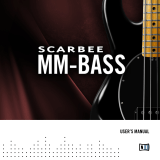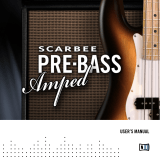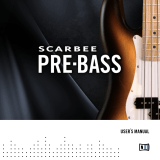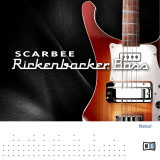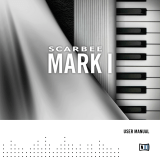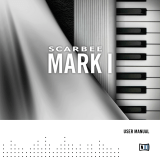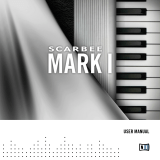Page is loading ...

USER’S MANUAL

The information in this document is subject to change without notice and does not represent a
commitment on the part of Native Instruments GmbH. The software described by this document is
subject to a License Agreement and may not be copied to other media. No part of this publication
may be copied, reproduced or otherwise transmitted or recorded, for any purpose, without prior
written permission by Native Instruments GmbH, hereinafter referred to as Native Instruments. All
product and company names are ™ or ® trademarks of their respective owners.
Manual written by Nils Liberg
Edited by Patryk Korman
Document Version: 1.0 (11/2009)
Product Version: 1.0 (11/2009)
Special thanks to the Beta Test Team, who were invaluable not just in tracking down bugs, but in
making this a better product.

Germany
Native Instruments GmbH
Schlesische Str. 28
D-10997 Berlin
Germany
info@native-instruments.de
www.native-instruments.de
USA
Native Instruments North America, Inc.
5631 Hollywood Boulevard
Los Angeles, CA 90028
USA
sales@native-instruments.com
www.native-instruments.com
© Native Instruments GmbH, 2009. All rights reserved.

Scarbee Jay-Bass Manual – IV
Table Of Contents
1 WelcometoScarbeeJay-Bass!..........................................................................................6
1.1 About the Bass ............................................................................................. 7
1.1.1 Neck ............................................................................................... 7
1.1.2 Body ............................................................................................... 8
1.2 Note to Users of Scarbee MM-Bass ................................................................. 8
1.3 The People Behind Scarbee Jay-Bass............................................................... 9
2 PlayingBassNotesonaKeyboard................................................................................... 11
2.1 Automatic String Selection ............................................................................11
2.2 Manual String Selection ................................................................................12
3 KeyLayout...................................................................................................................... 13
3.1 Fingered and Slapped .................................................................................. 14
4 Articulations................................................................................................................... 15
4.1 Sustains, Mutes and Harmonics .....................................................................15
4.2 Hammer-on/Pull-off ......................................................................................15
4.3 Fast Grace Note Up ......................................................................................16
4.4 Slides .........................................................................................................17
4.5 Buzz-trills, Trills ...........................................................................................19
4.6 Trill Tails .....................................................................................................19
4.7 Pickup Clap ................................................................................................ 20
4.8 Release Samples ......................................................................................... 21
5 PlayingTechniques.........................................................................................................22
5.1 Index and Middle Finger Alternation ............................................................... 22
5.2 Extended Hammer-on/Pull-off ....................................................................... 23
5.3 Cross Hammering ........................................................................................ 23
5.4 Chords ....................................................................................................... 24

Scarbee Jay-Bass Manual – V
5.5 Chord Slides ............................................................................................... 25
6 SustainingNotes.............................................................................................................26
7 Vibrato...........................................................................................................................27
8 InstrumentReset.............................................................................................................28
9 MainMenuandInstrumentSettings.................................................................................29
9.1 Player Prole .............................................................................................. 29
9.2 FX Presets ................................................................................................. 30
9.3 EQ ............................................................................................................ 31
9.4 Vibrato ....................................................................................................... 31
9.5 Release ..................................................................................................... 32
9.6 Release .................................................................................................... 33
9.7 Chords ....................................................................................................... 34
9.8 Alternation ................................................................................................. 35
9.9 Noise Levels ............................................................................................... 36
9.10 Controllers ................................................................................................. 36
9.11 Help .......................................................................................................... 37
10 DifferencesBetweenJay-BassandMM-Bass....................................................................38
11 ProductionCredits&ThankYou’s....................................................................................39

Scarbee Jay-Bass Manual – 6
1 Welcome to Scarbee Jay-Bass!
Scarbee Jay-Bass is built on the samples of J-Slap’n Fingered, but has been reprogrammed to
take advantage of our highly advanced scripting technology originally developed for MM-Bass.
Three pick-up settings: Bridge, Both and Neck have all been recorded in both a ngered and
slapped version – without the use of compression, tubes or EQ to ensure maximum exibility
in the sound production. It features an extensive set of playing techniques, for example:
• sustains
• mutes
• harmonics
• hammer-on & pull-off
• fast grace notes
• slides (in most any speed you could want)
• trills
• buzz-trills
• cross hammering
• chords
• chord slides
• index and middle nger alternation
• multiple sets of release samples: loose, tighter and tight.
Jay-Bass was designed to make it very easy to use all these while playing live. Except for
the trills and cross hammering you can trigger all of the articulations and techniques above
without the need for any keyswitches.
The full strings of the bass have been sampled in order to reproduce the timbre changes that
occur when you move between low and high frets on the string of a real bass. This results in
a very rich sound with all the natural overtones.
It should be noted that Jay-Bass is much more than just a collection of samples. It features
a sophisticated script, which takes care of many things automatically for you, for example:
SPRACHE IN Paragraph-Style “05 - STANDARD Fließtext” passend einstellen

Scarbee Jay-Bass Manual – 7
• string selection
• a fretboard display updated dynamically as you play
• alternation between index and middle nger
• chord recognition
• random alternation between three different types of release samples
• realistic vibrato
Furthermore, the script enables you to congure all settings including EQ, load and store FX
presets, and access documentation covering every aspect of the instrument directly through
the instrument performance view.
1.1 About the Bass
The instrument we used was an excellent and expensive danish hand built bass that has the
features of a classic funky late ´70s bass: The same shape and dimensions of the back of the
neck, the same pick-up placement, the same wood (body made of ash; neck and ngerboard
made of hardrock maple), Dunlop 6110 “jumbo” frets and bone nut.
1.1.1 Neck
Wood
1-piece hard rock maple, reinforced with graphite bars
Attachment
Bolt-on with threaded steel bolts and inserts
Fingerboard
Hard rock maple, black dot position markers
Scale
34"
Radius
Compound 7 1/4" / 12"
Frets
21, “jumbo” frets (Dunlop 6110)
Nut
Brass
Truss-rod
Single, adjustable at body
Tuning gears
Hipshot HB-1s
Finish
Matt satin acrylic, clear

Scarbee Jay-Bass Manual – 8
1.1.2 Body
Wood Finest select Danish White Ash
Pickup Lindy Fralin (vintage edition)
Controls 2 x volume, 1 x active bass, 1 x passive treble
Preamp Aguilar OBP-P passive/active
Bridge Badass Bass II
Straplocks Schaller
Finish High gloss, polyester
Strings DR MR-45 “Hi-BEam”
1.2 Note to Users of Scarbee MM-Bass
Jay-Bass was designed to mimic the functionality of MM-Bass as closely as possible, but us-
ing the samples from the J-Slap’n Fingered library. As a consequence most material in this
manual is equal to that of the MM-Bass manual. If you know MM-Bass well, you can safely
skip ahead to the section near the end that explains the various differences between MM-
Bass and Jay-Bass.

Scarbee Jay-Bass Manual – 9
1.3 The People Behind Scarbee Jay-Bass
Thomas Hansen Skarbye – The Bassist and Producer
When I was a boy, I wanted to be a great Magician. I wanted to amaze the audience and
leave them wondering: “How did he do that?“ Years later, I am still very fond of “illusions“ in
any media. I watch almost every movie that raises the bar of special effects and I share true
interest in computer and console games with my sons for the same reason. These days my
magic wand and top hat are the Scarbee Sample Libraries.
I have played in various funk bands as a bassist during my younger years, but started soon
to compose music for TV documentaries and aimed for a career as a lm composer. After
having composed and produced music for more than 150 commercials for TV and Cinema
(even working with Oscar winning director Bille August), I began to create Sample Libraries
and Virtual Instruments as I wanted better sounds to use for my productions. These products
are used by top artists around the world on albums and live.
Due to “Carpal Tunnel Syndrome“ (weak wrists) I invented an articial way of playing bass
using software in 1998 and released the Scarbee J-Slap & J-Fingered in 2000.
Originally I had planned a fretless bass release but I instead decided to take a break from the
basses and do some “easy“ vintage keyboard sounds to use in my productions. Ironically it
took me 5 years to complete the Vintage Keyboard Collection and the Vintage Keyboard FX
plugin! Not exactly an easy job as I expected, but this is me in a nutshell; I get into some-
thing, dig deeper and deeper, and slowly reveal the secrets and soul of an instrument, and
cannot stop until the job is done.
The Jay-Bass project started in 2007 just after the release of MM-Bass. Many users of
J-Slap‘n Fingered emailed me and asked if it was possible to use the BB programming with

Scarbee Jay-Bass Manual – 10
JSF. To begin with, I did not think this was possible but slowly I was convinced by Nils Liberg
that it could be possible if we only were prepared to spend some time on it. At the same time
I was involved in some bass programming for a funk producer; using J-Slap and Fingered it
was hard for me to go back to that “old” programming now that I had become used to the
wild luxury of the MM-Bass fretboard display and intelligent script. So eventually, I decided
to start the conversion, which proved to be just as time consuming and difcult as I had
expected but at the same time extremely rewarding.
Please enjoy our bass – we surely put a lot of love into it!
Nils Liberg – Script Developer
I was contacted by Thomas in the autumn of 2006 to create a KONTAKT script for what would
later become MM-Bass. After having completed it, we realized that this system also had the
potential of signicantly increasing the playability of J-Slap and Fingered. It took quite some
effort to translate JSF to function like MM-Bass, but I like to believe it turned out very well
in the end.
My goal with the script has been to make the instrument so easy to play that the user will
never feel it’s too much trouble to use any of the articulations. It feels doubly rewarding to
have been able to put all my creativity into something that I know will nally be used as part
of and benet another person’s creative expression. It is my hope that you will nd Jay-Bass
an inspiring instrument to use.
Nils Liberg is an experienced script developer and the author of a widely used script develop-
ment environment for Mac/PC.

Scarbee Jay-Bass Manual – 11
2 Playing Bass Notes on a Keyboard
With stringed instruments a certain note can often be played on multiple strings, and so the
player has to choose. For example, G2 can be played on all four strings of the bass with each
string having its own very distinctive sound. Many sample libraries and virtual instruments
take the simplistic route of recording only one sample per note (from the lower playing posi-
tions), which means that the user gets a very limited instrument.
Jay-Bass on the other hand includes samples of all the different strings each note can be
played on, thus capturing the sound of the whole instrument. In our view the samples at
higher frets is an integral part of the instrument and adds spice and variation to the sound.
When a real bass player is about to play a note, he/she typically chooses the string on which
the note can be played with minimum effort. That is, without moving the left hand too much.
On a keyboard, it’s difcult to manually perform this string selection in real-time and labori-
ous to do it after recording, so we came up with a way to let the Jay-Bass script do it for you.
2.1 Automatic String Selection
The gure below shows the main view of the instrument user interface. Note the white dotted
line above the fretboard. It represents the position of the left hand on the bass neck – the
playing position. When you play a note on the keyboard Jay-Bass automatically chooses a
string that minimizes the need to move the playing position (the left hand), similar to a real
bass player. This way you can get the full sound of the bass with minimum effort. Eg. if you
play an octave interval the correct strings will automatically be used.
That's the basic operation, but the automatic string selection also takes many other things into
account such as when to use open strings and what special rules to use for each articulation.
Articulation specic symbols are displayed on the fretboard on the selected string/fret as
shown above, and the text label below the fretboard shows the name of the last used ar-
ticulation. Each string is monophonic so a new note interrupts any earlier one on the same
string – just like on a real bass. Simply trying out Jay-Bass, oneself is perhaps the best way
to understand how it works.

Scarbee Jay-Bass Manual – 12
2.2 Manual String Selection
It is also possible to control the string selection manually. Each string has an associated key
switch: E0, A0, D0, G0 – picked to be easy to remember. In MM-Bass-Amped, a key switch
affects the following note or remains active for as long as you hold it pressed. To return to the
normal mode of operation, just release the key switch. It is possible to combine more than
one string key switch. For example you can hold A0 and D0 pressed simultaneously to make
A and D be the preferred strings.
Another way of controlling the string choice is by using key switches F5-B6 to specify which
frets you prefer. The F5 key corresponds to the rst fret, F#5 to the second fret and so on.
To make it easier to learn we made the fret key switches match the corresponding note on
the E-string of a bass (F is the rst fret on this string, F# the second and so on). By pressing
and releasing one of these key switches you move the playing position and at the same time
trigger a fret noise sample (different noises are used depending on how far you move). You
can also lock the playing position by holding one of these key switch pressed while playing.
As will be shown later it is also possible to use a MIDI Controller for fret selection.

Scarbee Jay-Bass Manual – 13
3 Key Layout
Here is a schematic of the keys in Jay-Bass. The red keys are key switches and the blue ones
mapped to normal samples
1
. This is just an overview. Instructions on how to use each key
switch and what it does is given in the following text sections.
1
The bass has no B string, but for exibility the notes B0 to D#1 have been mapped to a virtual B string.
These notes use stretched E string samples. Only basic articulations like sustain, mutes, hammer-on and
pull-off are available on the virtual B string.

Scarbee Jay-Bass Manual – 14
3.1 Fingered and Slapped
► To use ngered playing style, load one of the instrument (.nki) les.
► To use both ngered and slapped, load one of the Both multi (.nkm) les.
• The C5/D5 keyswitches are used to switch between ngered and slap respectively.
• See the installation notes above for a short description of each patch.
•
If you use a combi with both ngered and slapped, you don’t need to have the perfor-
mance view of slapped open. The visibility of performance views can be toggled by click-
ing on the corresponding instrument icon.

Scarbee Jay-Bass Manual – 15
4 Articulations
4.1 Sustains, Mutes and Harmonics
Sustain is the default articulation. For velocities below 40, you get mutes instead, and for
velocities below 15, you get harmonics where available and mutes otherwise. Enough veloci-
ties layers have been recorded to achieve natural transitions from soft to hard playing. Please
note that harmonics are mapped to the string/fret where they are played on a real bass and
not to the pitch of the sound.
If you activate the mutes key switch (A#1), you will get mutes irrespectively of the velocity.
This can be used to make it easier to trigger mutes since you do not need to rely on getting
the right velocity when using it.
4.2 Hammer-on/Pull-off
Legato
To trigger a hammer-on or pull-off you simply play a half- or whole
note either down or up legato (overlapping the earlier note). If a
hammer-on or pull-off is not available (eg. when playing a note le-
gato downwards from fret 1), you will get a sustain instead.
Hammer-on / pull-off for intervals greater than 1-2 semitones may
be played by activating the F#0 key switch. See more about this
further down.

Scarbee Jay-Bass Manual – 16
4.3 Fast Grace Note Up
Fast Legato
A fast grace note is triggered in the same way as a hammer-on,
one needs to play the legato note very quickly after the previous
note. Eg. play a C2, hold it pressed and press a D2 quickly after
(between 20 and 60 milliseconds).
The velocity of the lower note – the pre-hit note – is used as the
velocity for playing the fast grace note sample. This allows you to
play the second note at any velocity, which can help because one
often ends up hitting it a bit harder since it has to be triggered so
fast.
It was an old dream since the year 2000 to be able to trigger fast
grace notes in an intuitive way and now it has nally come true –
no key switches are necessary!

Scarbee Jay-Bass Manual – 17
4.4 Slides
Legato
+
Slides are available in two, for some strings three, different speeds.
To trigger a slide play a note legato while holding the sustain pedal
pressed. If you played a short slide of one or two semitones the
slide will end automatically. For longer slides you need to press the
target note once again when you want the slide to end.
If it’s not possible to slide the played interval without going outside
of the available frets, a sustain will be used instead. The velocity of
the target note determines the speed of the slide. There are three
recorded slide speeds:
• Velocities 1-30 trigger the slowest slide sample
• Velocities 31-60 trigger the middle slide sample
• Velocities 61-127 trigger the fastest slide sample
If you trigger a speed, which is not available, the closest matching
speed will be used instead.

Scarbee Jay-Bass Manual – 18
Below there is a table of ranges where each type of slide sample is
available. You typically don’t have to think about this since they are
remapped automatically, but it’s here for completeness.
Fingered Slap
Slowslidesup
E string: Fret 0-9
A string: Fret 0-9
D string: Fret 0-9
G string: Fret 0-11
E string: Fret 0-9
A string: Fret 0-9
D string: Fret 0-9
G string: Fret 0-11
Middleslidesup
E string: Fret 0-9
A string: Fret 0-9
D string: Fret 0-9
G string: Fret 0-11
E string: Fret 0-9
A string: Fret 0-9
D string: N/A
G string: N/A
Fastslidesup
E string: Fret 0-9
A string: Fret 0-9
D string: N/A
G string: N/A
E string: Fret 0-9
A string: Fret 0-9
D string: N/A
G string: N/A
Slowslidesdown
E string: Fret 4-21
A string: Fret 4-21
D string: Fret 4-21
G string: Fret 3-21
E string: Fret 4-21
A string: Fret 4-21
D string: Fret 4-21
G string: Fret 5-21
Middleslidesdown
E string: N/A
A string: N/A
D string: N/A
G string: N/A
E string: N/A
A string: N/A
D string: N/A
G string: N/A
Fastslidesdown
E string: Fret 4-21
A string: Fret 4-21
D string: Fret 4-21
G string: Fret 3-21
E string: Fret 4-21
A string: Fret 11-21
D string: N/A
G string: N/A

Scarbee Jay-Bass Manual – 19
4.5 Buzz-trills, Trills
A buzz-trill is the sound of a real bass player moving his nger
back and forth over a fret quickly. A trill on the other hand is a se-
quence of repeated hammer-on and pull-offs. Buzz-trills and trills
are activated by pressing the G#0 key switch. Buzz-trills are avail-
able on the D and G string and trills on the G string.
•
Velocities 1-59 give trills on G string and buzz-trills on D string.
• Velocities 60-127 give short buzz-trills
Note that unlike the other key switches G#0 only affects the follow-
ing note even if it were to be held pressed. We made it like this to
make it easier to trigger a single trill without accidentally affecting
other notes.
4.6 Trill Tails
+
Legato (down)
Trill tails are based on the same samples as trills except that their
attack has been removed in order to make it possible to use them
after any other articulation – as a tail. They are available on the G
string.
To trigger a trill tail press the G#0 key switch to activate trill mode
and then play a pull-off (a half or whole note legato down). Please
note that the key switch must be pressed just before the pull-off
note and not earlier or you will get a trill or buzz-trill instead of a
sustain on the preceding note.
Here’s an example of how a trill tail can be performed: play A3 and
hold it pressed, play the G#0 key switch, play a legato down to G3.
The G3 legato note is played back as a trill tail.

Scarbee Jay-Bass Manual – 20
4.7 Pickup Clap
Play A#0 to get the sound of a pickup clap. Please note that A#0
behaves more like a normal note than a key switch – the A#0 itself
triggers the sound and it does not affect other notes. As many as
27 different pickup clap samples are included.
A real bass player typically hits the pick-up with his/her right hand
on snare drum hits (2/4) to keep the beat – or as some advanced
players: hit the pick-up as a aminco guitarist in between notes for
a funky, unique bass groove.
/
